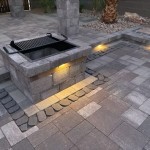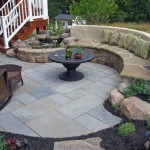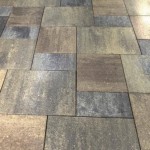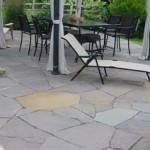How To Build a Flagstone Patio Without Cement
Constructing a flagstone patio without cement provides a viable and aesthetically pleasing alternative to traditional mortar-set installations. This method, often referred to as a dry-laid patio, emphasizes natural drainage and flexibility, minimizing the risk of cracking that often occurs with rigid cement bases. This article details the process of constructing a flagstone patio sans cement, covering site preparation, material selection, installation techniques, and essential considerations for long-term stability.
The success of a dry-laid flagstone patio hinges on meticulous planning and execution. Unlike cement-based patios, which rely on a solid, monolithic foundation, dry-laid patios depend on a series of carefully compacted layers to provide stability and prevent shifting. The absence of cement allows for natural water percolation, reducing hydrostatic pressure that can contribute to patio failure, especially in regions with freeze-thaw cycles. Furthermore, a dry-laid patio can be easier to repair or adjust in the future, as individual stones can be readily removed and replaced without disrupting the entire structure.
Key Point 1: Site Preparation and Excavation
Proper site preparation is paramount for the longevity and stability of a flagstone patio, particularly one installed without cement. The initial step involves defining the patio's perimeter. This is best accomplished by using stakes and string to outline the desired shape and dimensions. Accuracy in this stage will ensure the final patio aligns with the planned design.
Following the outline, excavation begins. The depth of excavation depends on several factors, including the thickness of the flagstone, the depth of the base materials, and the anticipated traffic load. A general guideline is to excavate to a depth of approximately 8 to 12 inches. This allows for a sufficient layer of compacted gravel, followed by a leveling layer of sand or stone dust.
The excavation should extend beyond the planned patio perimeter by at least 6 inches on all sides. This over-excavation provides space for edging materials or allows for a more gradual transition to the surrounding landscape. During excavation, it is crucial to maintain a consistent grade that slopes slightly away from any adjacent structures, such as a house or building. This slope ensures proper drainage and prevents water from pooling on the patio surface or seeping into the foundation.
After the initial excavation, the exposed soil should be thoroughly compacted using a plate compactor. Compaction is essential to prevent settling and to provide a stable subgrade for the base materials. Poorly compacted soil can lead to unevenness and instability in the patio over time.
Once the subgrade is compacted, a layer of landscape fabric should be installed over the entire excavated area. The landscape fabric serves as a barrier, preventing soil from mixing with the base materials and inhibiting weed growth. The fabric should extend beyond the edge of the excavation and can be trimmed after the patio is completed.
Key Point 2: Base Material Installation and Compaction
The selection and installation of base materials are critical elements in constructing a flagstone patio without cement. The base materials provide a stable, well-draining foundation that supports the flagstone and prevents shifting or settling. The primary base material is typically crushed gravel, often referred to as road base or aggregate base.
The crushed gravel should be installed in layers, each layer no more than 4 inches thick. Each layer must be thoroughly compacted using a plate compactor before the next layer is added. Compacting in thinner lifts ensures uniform density and prevents voids from forming within the base. A properly compacted gravel base is essential for distributing weight evenly and preventing differential settling.
The total depth of the gravel base should be at least 6 to 8 inches, depending on the soil conditions and anticipated use of the patio. In areas with heavy clay soils or high water tables, a thicker base may be necessary to provide adequate drainage. After the gravel base is compacted, a layer of leveling material is added. This layer typically consists of sand, crushed stone dust, or decomposed granite.
The leveling layer should be approximately 1 to 2 inches thick and is used to create a smooth, even surface for setting the flagstone. The leveling material should be screeded to ensure a consistent depth across the entire patio area. A screed board, which is a straight piece of lumber, is used to level the material to the desired height. This process creates a perfectly flat surface that will accommodate the flagstone without wobbling or rocking.
It's important to note that the leveling layer should be dampened lightly before screeding. This helps to compact the material and prevent it from shifting during the screeding process. However, avoid over-wetting the leveling layer, as excessive moisture can create inconsistencies in density and affect the stability of the flagstone.
Key Point 3: Flagstone Installation and Joint Stabilization
With the base materials properly installed and compacted, the next step is to lay the flagstone. This process involves selecting and arranging the stones to create a visually appealing and structurally sound patio surface. Start by laying out the flagstones in a pattern that is both aesthetically pleasing and efficient in terms of material usage. Irregularly shaped flagstones can be arranged to create a naturalistic look, while more uniform stones can be laid in a more formal pattern.
When laying the flagstone, it is important to maintain consistent spacing between the stones. This spacing, known as the joint width, typically ranges from ½ inch to 2 inches, depending on the desired appearance and the size of the flagstones. The joints provide space for drainage and allow for slight adjustments in the stone placement. As each stone is placed, check for stability and levelness. Use a rubber mallet to gently tap the stone into the leveling layer, ensuring that it sits firmly and does not rock. If a stone is too high, remove it and add or remove leveling material as needed.
Once the flagstones are set, the joints must be filled with a stabilizing material. Several options are available, including sand, crushed stone dust, polymeric sand, or decomposed granite. The choice of material depends on the desired appearance, the level of foot traffic, and the environmental conditions. Sand or crushed stone dust provides a natural look and allows for excellent drainage. Polymeric sand contains binding agents that harden when wetted, providing increased stability and weed resistance. Decomposed granite offers a rustic appearance and can be compacted to create a firm, stable surface.
Regardless of the chosen material, it is important to thoroughly fill the joints between the flagstones. Use a broom to sweep the material into the joints, ensuring that they are completely filled. After filling the joints, lightly water the patio to settle the material and compact it further. If using polymeric sand, follow the manufacturer's instructions for activation and watering, as improper installation can lead to staining or other issues.
The edging of the patio provides a finished look and helps to contain the flagstone and base materials. Several options are available for edging, including plastic edging, metal edging, brick pavers, or natural stones. The edging should be installed around the perimeter of the patio and secured with stakes or fasteners. Backfilling with soil or gravel helps to stabilize the edging and prevent it from shifting.
Regular maintenance is essential for preserving the appearance and stability of a dry-laid flagstone patio. This includes sweeping the surface to remove debris, re-filling the joints as needed, and addressing any settling or shifting that may occur over time. By following these steps, it is possible to construct a beautiful and durable flagstone patio that will provide years of enjoyment without the need for cement.

How To Build A Flagstone Patio In One Day Merrypad

Extend Ur Patio Without Using Concrete Super Easy All U Need Pavers Sand A Level And Gravel Diy Backyard

How To Install A Flagstone Path Without Using Gravel Or Roadbase

How To Build A Flagstone Patio Without Cement Ehow

How To Lay Flagstone Installation Guide Landscaping Network

How To Lay Flagstone Installation Guide Landscaping Network

Flagstone Patios How To Guide Paving Cost Diy Vs Contractor Install Mutualmaterials Com

How To Build A Flagstone Patio Helpful Guide

How To Install A Flagstone Walkway True Value

How To Install A Flagstone Patio Handyman Startup
Related Posts








